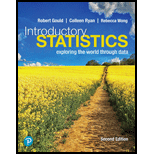
Brain Games (Example 2) Researchers are interested in testing whether a video game that is designed to increase brain activity actually works. To test this, they plan to randomly assign subjects to either the treatment group (spend 15 minutes per day playing the game) or a control group (spend 15 minutes per day surfing the Web). At the end of the study, the researchers will administer a test of “brain teasers” to see which group has the greater mental agility. Because they suspect that age might affect the outcome, the researchers will create blocks of ages: 18-25, 26-35, 36-45, and 46-55. To randomly assign subjects to treatment or control, they will place four tickets in a box. The tickets are labeled with the age groups. When an age group is selected, everyone in that age group will be assigned to the treatment group. They will select two age groups to go to treatment, and two to go to control. Is this an appropriate use plan.
Want to see the full answer?
Check out a sample textbook solution
Chapter 12 Solutions
Pearson eText Introductory Statistics: Exploring the World Through Data -- Instant Access (Pearson+)
Additional Math Textbook Solutions
College Algebra (7th Edition)
APPLIED STAT.IN BUS.+ECONOMICS
Calculus: Early Transcendentals (2nd Edition)
Elementary & Intermediate Algebra
Mathematics for the Trades: A Guided Approach (11th Edition) (What's New in Trade Math)
Thinking Mathematically (6th Edition)
- 6. Show that, for any random variable, X, and a > 0, Lo P(x -00 P(x < xarrow_forward5. Suppose that X is an integer valued random variable, and let mЄ N. Show that 8 11118 P(narrow_forward食食假 6. Show that I(AUB) = max{1{A}, I{B}} = I{A} + I{B} - I{A} I{B}; I(AB)= min{I{A}, I{B}} = I{A} I{B}; I{A A B} = I{A} + I{B}-21{A} I{B} = (I{A} - I{B})². -arrow_forward11. Suppose that the events (An, n ≥ 1) are independent. Show that the inclusion- exclusion formula reduces to P(UAL)-1-(1-P(Ak)). k=1 k=1arrow_forward8. Show that, if {Xn, n≥ 1} are independent random variables, then sup X,, A) < ∞ for some A.arrow_forward20. Define the o-field R2. Explain its relation to the o-field R.arrow_forward11. (a) Define the (mathematical and conceptual) definition of conditional probability P(A|B).arrow_forward12. (a) Explain tail events and the tail o-field. Give an example.arrow_forwardLet A, A1, A2,... be measurable sets. Then P(A)=1- P(A); • P(Ø) = 0; P(A1 UA2) ≤ P(A1) + P(A2); A1 C A2 P(A1) P(A2); P(UA) + P(n=14) = 1. Exercise 3.1 Prove these relations. ☐arrow_forwardarrow_back_iosSEE MORE QUESTIONSarrow_forward_iosRecommended textbooks for you
 Holt Mcdougal Larson Pre-algebra: Student Edition...AlgebraISBN:9780547587776Author:HOLT MCDOUGALPublisher:HOLT MCDOUGAL
Holt Mcdougal Larson Pre-algebra: Student Edition...AlgebraISBN:9780547587776Author:HOLT MCDOUGALPublisher:HOLT MCDOUGAL Big Ideas Math A Bridge To Success Algebra 1: Stu...AlgebraISBN:9781680331141Author:HOUGHTON MIFFLIN HARCOURTPublisher:Houghton Mifflin Harcourt
Big Ideas Math A Bridge To Success Algebra 1: Stu...AlgebraISBN:9781680331141Author:HOUGHTON MIFFLIN HARCOURTPublisher:Houghton Mifflin Harcourt Glencoe Algebra 1, Student Edition, 9780079039897...AlgebraISBN:9780079039897Author:CarterPublisher:McGraw Hill
Glencoe Algebra 1, Student Edition, 9780079039897...AlgebraISBN:9780079039897Author:CarterPublisher:McGraw Hill
 College Algebra (MindTap Course List)AlgebraISBN:9781305652231Author:R. David Gustafson, Jeff HughesPublisher:Cengage Learning
College Algebra (MindTap Course List)AlgebraISBN:9781305652231Author:R. David Gustafson, Jeff HughesPublisher:Cengage Learning
 Holt Mcdougal Larson Pre-algebra: Student Edition...AlgebraISBN:9780547587776Author:HOLT MCDOUGALPublisher:HOLT MCDOUGAL
Holt Mcdougal Larson Pre-algebra: Student Edition...AlgebraISBN:9780547587776Author:HOLT MCDOUGALPublisher:HOLT MCDOUGAL Big Ideas Math A Bridge To Success Algebra 1: Stu...AlgebraISBN:9781680331141Author:HOUGHTON MIFFLIN HARCOURTPublisher:Houghton Mifflin Harcourt
Big Ideas Math A Bridge To Success Algebra 1: Stu...AlgebraISBN:9781680331141Author:HOUGHTON MIFFLIN HARCOURTPublisher:Houghton Mifflin Harcourt Glencoe Algebra 1, Student Edition, 9780079039897...AlgebraISBN:9780079039897Author:CarterPublisher:McGraw Hill
Glencoe Algebra 1, Student Edition, 9780079039897...AlgebraISBN:9780079039897Author:CarterPublisher:McGraw Hill
 College Algebra (MindTap Course List)AlgebraISBN:9781305652231Author:R. David Gustafson, Jeff HughesPublisher:Cengage Learning
College Algebra (MindTap Course List)AlgebraISBN:9781305652231Author:R. David Gustafson, Jeff HughesPublisher:Cengage Learning